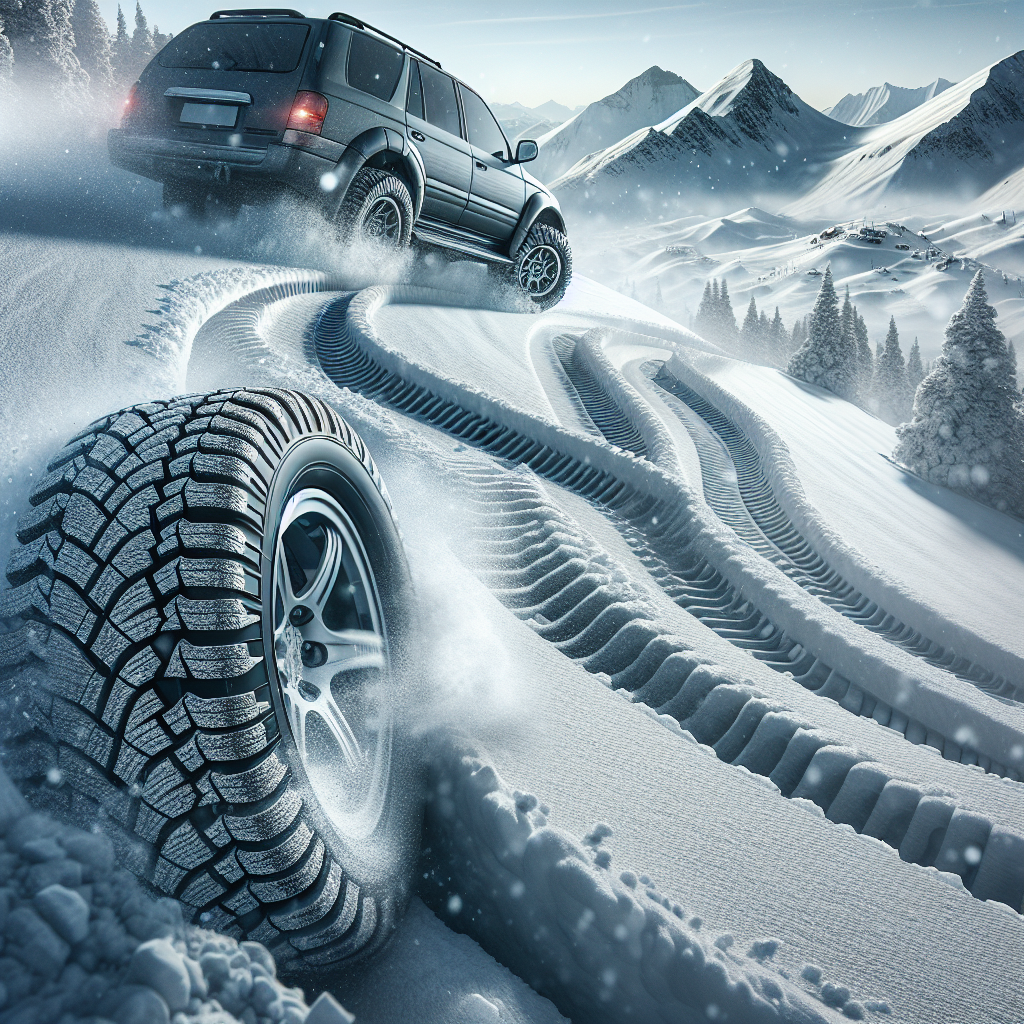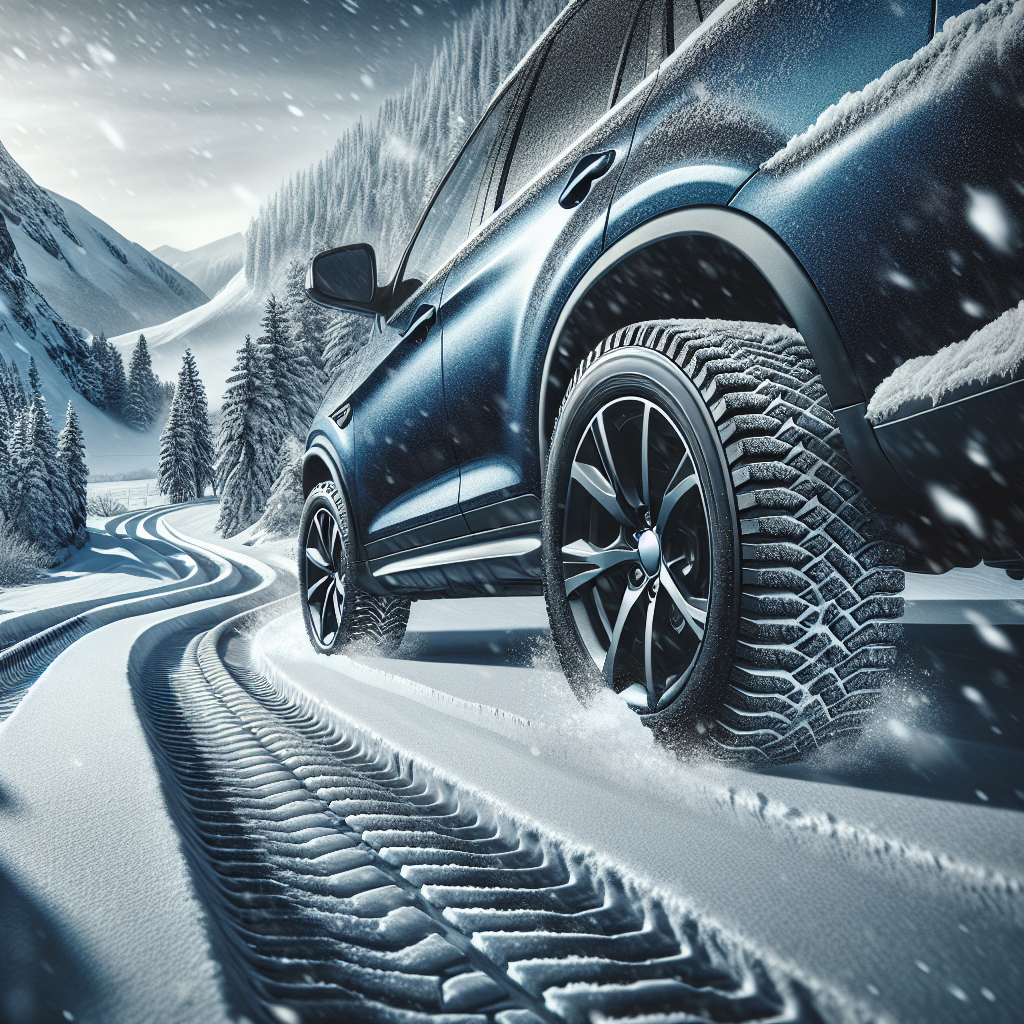Picture this: it’s a chilly winter morning and you’re driving up a steep hill, unsure of how your regular tires will handle the slippery road. But what if there was a solution to ensure your safety and peace of mind? In this article, we will explore the performance of winter tires on hills and steep inclines. Discover how these specialized tires can provide the traction you need to tackle any winter obstacle with ease. So buckle up and get ready to navigate those icy hills like a pro!

Tire Tread Design
Deep Tread Grooves
When it comes to tackling hills and steep inclines in winter conditions, an essential aspect to consider is the tread design of your tires. Deep tread grooves play a vital role in providing the necessary traction on snowy and icy surfaces. These grooves are designed to channel water, slush, and snow away from the tire’s contact patch, allowing the tire to grip the road more effectively. The deeper the tread grooves, the better the tire’s ability to maintain traction on hills.
Siping
Another important element of tire tread design, especially for hills and inclines, is siping. Siping refers to the small cuts or channels in the tire’s tread blocks. These tiny slits help improve traction by creating thousands of ‘biting edges’ that grip into the snow or ice. Sipes enhance the tire’s grip on hills by increasing the tire’s ability to dig into the surface and maintain control. So, when choosing winter tires for hilly terrains, look for those with well-designed and plentiful sipes to optimize your traction.
Block Edges
The design of the tire’s block edges also plays a significant role in its hill-climbing abilities. Block edges are the sharp edges found on the tread blocks. These edges provide additional biting points that help the tire grip onto the snow or ice-covered hill. By interlocking with the road surface, block edges enhance stability and control, ensuring your vehicle maintains traction even when climbing steep inclines. So, pay attention to the block edge design when selecting tires suitable for hilly winter driving.
Tire Grip
Rubber Compound
Apart from tread design, the rubber compound used in winter tires greatly influences their performance on hills and steep inclines. Winter tires are specially formulated with a softer rubber compound that remains flexible even in freezing temperatures. This soft compound allows the tire to conform to the contours of the road, maximizing grip and traction. When climbing hills, it is crucial to have tires that can maintain their flexibility and grip, ensuring stability and preventing slipping or sliding.
Road Contact
The amount of tire surface in contact with the road is another crucial factor for hill performance. Winter tires generally have a wider contact patch than all-season or summer tires. This increased contact area maximizes traction by distributing the vehicle’s weight more evenly. The larger contact area ensures that more tread block surface touches the road, providing better grip and traction on hills and steep inclines. So, when driving in hilly winter conditions, opt for winter tires that offer a wider contact patch for enhanced performance.
Studless vs Studded Tires
When it comes to choosing winter tires for hills and steep inclines, you may come across two main options: studless and studded tires. studless winter tires are designed with advanced tread patterns and rubber compounds to provide optimal traction on winter roads. The absence of metal studs makes them a suitable choice for areas where studded tires may be banned due to road damage concerns. On the other hand, studded tires feature metal studs embedded in the tread for enhanced grip on icy surfaces. These studs can provide exceptional traction on ice but may not be as effective on other winter road conditions. Consider the specific demands of hill climbing and surfaces you’ll encounter when deciding between studless and studded winter tires for hilly terrains.
Tire Size and Pressure
Tire Width
The size of your tires plays a crucial role in their performance on hills and inclines. Wider tires tend to have a larger contact patch, allowing for improved traction and stability. When driving in hilly winter conditions, it is advisable to choose winter tires that are slightly wider than your regular tires. The wider width provides better grip and traction, especially when climbing steep inclines. However, it is essential to ensure that the wider tires are compatible with your vehicle’s specifications and will not cause any interference or clearance issues.
Aspect Ratio
Another consideration when it comes to tire size is the aspect ratio. Aspect ratio refers to the height of the tire’s sidewall in relation to its width. A lower aspect ratio indicates a shorter sidewall, while a higher aspect ratio means a taller sidewall. When climbing hills and steep inclines, opting for tires with a slightly higher aspect ratio can be beneficial. The taller sidewalls offer more flex and cushioning, allowing the tire to conform better to the road surface and maintain traction.
Tire Pressure
Proper tire pressure is crucial for optimal performance on hills and steep inclines. It is essential to ensure that your tires are inflated to the recommended pressure specified by the vehicle manufacturer or tire manufacturer. Underinflated tires may negatively impact traction, causing the tire to deform and reduce the contact patch with the road surface. On the other hand, overinflated tires can lead to decreased grip and stability. Maintaining the correct tire pressure ensures that the tires maintain their shape and provide the necessary traction for safe hill climbing.
Traction Control Systems
Understanding Traction Control Systems
Modern vehicles are equipped with advanced traction control systems that help optimize tire grip and traction. These systems use various sensors to monitor wheel speed, acceleration, and other factors to detect when a loss of traction is imminent. When the system detects wheel slippage, it automatically applies the brakes or adjusts engine power to specific wheels to regain control and enhance traction. Understanding how your vehicle’s traction control system functions can help you make better decisions while driving on hills.
Effectiveness on Hills
Traction control systems can be particularly effective on hills and steep inclines. When climbing a hill, if the system detects that one or more wheels are losing traction, it can quickly intervene and apply brakes to the spinning wheel(s) while redirecting power to the wheels with better traction. This intervention helps prevent wheel spin and allows for smoother and more controlled hill climbing. However, it is important to note that while traction control systems can enhance grip, they are not infallible and should not be solely relied upon. Choosing appropriate winter tires and employing safe driving practices are also crucial for navigating hills in icy or snowy conditions.
Interactions with Winter Tires
When it comes to using traction control systems with winter tires, there can be a synergy that enhances overall traction. Winter tires are specifically designed to provide better grip and traction in snowy and icy conditions. When combined with a properly functioning traction control system, the two together can provide optimal performance on hills and steep inclines. The system can complement the grip provided by winter tires, ensuring that your vehicle maintains control and stability in challenging winter driving scenarios.

Climbing
Grip on Snow-Covered Hills
When climbing snow-covered hills, the grip provided by winter tires becomes crucial. The deep tread grooves, siping, and block edges discussed earlier come into action, ensuring that the tire can dig into the snow and maintain a firm grip. The rubber compound of winter tires stays pliable even in freezing temperatures, allowing the tire to conform to the contours of the snowy surface. This combination of tread design and rubber compound enables excellent traction on snow-covered hills, providing the confidence needed to navigate challenging winter terrain.
Handling Ice and Hardpack
In addition to snowy hills, winter driving often involves encountering icy patches or hardpacked snow. Winter tires excel in providing grip on these surfaces as well. The siping and block edges on the tread create biting edges that can grip onto the ice, allowing for better control and minimizing the risk of sliding. The softer rubber compound remains flexible in low temperatures, enabling the tire to conform to the irregularities of the hardpacked surface, thereby enhancing traction. With the right winter tires, you can confidently handle icy and hardpacked hills without compromising control and safety.
The Role of Winter Tire Performance
Winter tire performance is a crucial factor when it comes to climbing hills in winter conditions. The tread design, rubber compound, and overall quality of winter tires directly influence their ability to maintain traction on hills. Using winter tires specifically designed for snowy and icy conditions significantly improves your vehicle’s ability to climb hills with confidence and control. It is important to choose the right winter tires based on the expected conditions, ensuring their optimal performance in various winter driving scenarios.
Descending
Braking on Winter Hills
Descending hills in winter conditions requires careful consideration due to the increased risk of sliding or losing control. When it comes to braking on winter hills, winter tires play a critical role. The tread design of winter tires, including block edges and deep grooves, help channel away water, slush, and snow, allowing the tire to maintain a better grip on the road surface. This improved grip contributes to shorter braking distances, giving you more control over your vehicle when descending hills in wintry conditions.
Effectiveness of Winter Tires
Winter tires are specifically designed to provide superior traction and grip on snowy and icy surfaces. When descending hills, their performance is just as crucial as when climbing. The tread design, rubber compound, and siping on winter tires ensure that they maintain flexibility and conform to the road surface, maximizing traction even during downhill maneuvers. The block edges and tread grooves allow the tire to disperse water, slush, and snow, preventing hydroplaning and maintaining control. With the right set of winter tires, you can confidently navigate downhill sections of hills in winter conditions.
Consideration for Stopping Distance
One important factor to always keep in mind when descending hills in winter conditions is the increased stopping distance. It takes longer to come to a complete stop on slippery surfaces, such as snowy or icy roads. Winter tires can significantly reduce the stopping distance by providing better grip and traction. However, it is crucial to adjust your driving style accordingly and allow for increased braking distances. Maintaining a safe distance from the vehicle ahead and anticipating any potential hazards can help mitigate the risks associated with braking on winter hills.

Additional Considerations
Steep Grades
When driving on hilly terrains in winter, one challenge that may arise is encountering steep grades. Steep grades present additional challenges due to the increased incline and potential loss of traction. It is crucial to choose winter tires that are specifically designed for hilly terrain and capable of providing optimal grip on steep grades. Tread design, siping, block edges, and rubber compound all contribute to the tire’s ability to maintain traction on these challenging inclines, allowing you to navigate steep grades with confidence.
Weight Distribution
Maintaining proper weight distribution is crucial on hilly terrains, especially when driving in winter conditions. Adequate weight distribution ensures that the tire’s contact patch is maximized, enhancing traction and grip. When ascending or descending hills, it is essential to distribute the weight evenly in your vehicle. Avoid overloading one side or exceeding the recommended weight limits, as it can affect your vehicle’s stability and potentially result in loss of traction. Proper weight distribution combined with the right winter tires can significantly enhance your vehicle’s performance on hilly terrains.
Trailers and Towing
If you are towing trailers or carrying heavy loads while driving on hilly terrains in winter, it is essential to consider the impact on tire performance and traction. The additional weight can affect the tire grip, potentially compromising your vehicle’s ability to safely climb or descend hills. When towing or carrying heavy loads, ensure that your tires are appropriately rated for the weight being transported. Consider using winter tires designed for enhanced load-carrying capacities to maintain optimal traction and stability while towing or carrying heavy loads on hilly terrains.
Driver Skills and Techniques
Maintaining Controlled Speed
When driving on hills in winter conditions, one crucial skill to develop is maintaining controlled speed. Excessive speed can lead to loss of control, especially when climbing or descending steep inclines. It is essential to drive at a speed that allows for proper tire grip and ensures that you have enough time to react to any potential hazards. Remaining within a safe speed range, considering the road conditions, and adjusting your speed accordingly are key to navigating hilly terrains safely in winter.
Using Lower Gears
Using lower gears can significantly assist in maintaining control while driving on hills in winter conditions. Lower gears increase engine braking, reducing the reliance on the regular braking system. When descending hills, downshifting to a lower gear allows the engine to slow the vehicle down, minimizing the risk of overheating the brakes and improving overall control. Similarly, when climbing hills, using lower gears can provide the necessary torque to maintain traction and control. Proper utilization of lower gears, in combination with winter tires, can enhance your vehicle’s performance on hilly terrains.
Avoiding Sudden Maneuvers
In winter driving, sudden maneuvers can have severe consequences, especially on hilly terrains. Rapid accelerations, harsh braking, or sudden steering inputs can lead to loss of control, resulting in accidents or potentially dangerous situations. It is crucial to anticipate any potential hazards, plan your maneuvers in advance, and execute them smoothly and gradually. Avoid sudden shifts in speed, abrupt braking, or jerky steering movements to maintain stability and control on hills in winter conditions. Practicing smooth and controlled driving techniques, along with using winter tires designed for enhanced grip, can significantly improve your safety on hilly terrains.

Safety and Precautions
Proper Alignment and Balancing
Maintaining proper alignment and balancing of your tires is essential for optimal performance on hills in winter conditions. Misaligned or unbalanced tires can lead to uneven wear and compromised grip, which may result in reduced traction on hilly terrains. Regular wheel alignment and tire balancing ensure that weight is distributed evenly across all tires, optimizing tire performance and enhancing grip. Properly aligned and balanced tires, in combination with winter tire technology, maximize your safety and control on hills during winter driving.
Regular Tire Maintenance
Routine tire maintenance is crucial for safe and efficient driving on hilly terrains in any season, and winter is no exception. Regularly inspecting your tires for signs of wear, maintaining the recommended tire pressure, and checking for tread depth are vital steps to ensure optimal grip and traction. Properly inflated tires with adequate tread depth provide better control and reduce the risk of hydroplaning on wet or slushy roads. Regular tire maintenance, combined with the use of winter tires, enhances your vehicle’s safety and performance on hilly terrains in winter.
Knowing Your Vehicle’s Limits
Understanding the capabilities and limitations of your vehicle is vital for safe driving on hilly terrains in winter conditions. Different vehicles may have varying traction control systems, weight distributions, and handling characteristics. It is crucial to familiarize yourself with your vehicle’s specific attributes and adjust your driving style accordingly. Knowing your vehicle’s limits, along with choosing the appropriate winter tires and employing safe driving techniques, ensures that you make informed decisions and stay in control while driving on hills in winter conditions.
Conclusion
Winter tires are a crucial aspect of safely navigating hills and steep inclines during winter conditions. The combination of their tread design, rubber compounds, and overall performance greatly enhances grip and traction on snowy, icy, and hilly terrains. Deep tread grooves, siping, and block edges provide essential traction, while wider contact patches distribute weight more evenly, optimizing grip. When choosing winter tires, consider factors such as tread design, siping, block edges, rubber compounds, and compatibility with your vehicle. Additionally, practicing safe driving techniques, understanding your vehicle’s capabilities, and maintaining proper tire maintenance contribute to overall performance on hills in winter conditions. Remember, winter tires are a crucial investment to ensure your safety and control when driving on hilly terrains during winter. Stay informed, choose wisely, and enjoy the winter season with confidence.


